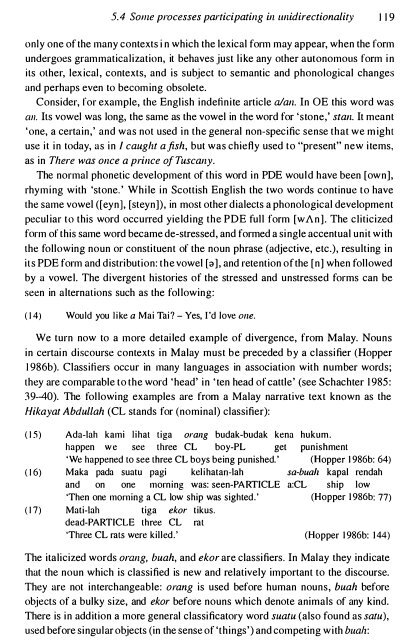Gram - SEAS
Gram - SEAS
Gram - SEAS
Create successful ePaper yourself
Turn your PDF publications into a flip-book with our unique Google optimized e-Paper software.
5.4 Some pIVcesses participating in Llllidirectionality I 19<br />
only one of the many contexts in which the lexical form may appear, when the form<br />
undergoes grammaticalization, it behaves just like any other autonomous form in<br />
its other, lexical, contexts, and is subject to semantic and phonological changes<br />
and perhaps even to becoming obsolete.<br />
Consider, for example, the English indefinite article alan. In DE this word was<br />
ClIl. Its vowel was long, the same as the vowel in the word for 'stone,' stall. It meant<br />
'one, a certain,' and was not used in the general non-specific sense that we might<br />
use it in today, as in I caught afish, but was chiefly used to "present" new items,<br />
as in There was once a prince o/ Tuscany.<br />
The normal phonetic development of this word in PDE would have been [own],<br />
rhyming with 'stone.' While in Scottish English the two words continue to have<br />
the same vowel ([eynJ. [steyn]), in most other dialects a phonological development<br />
peculiar to this word occurred yielding the PDE full form [wAn]. The c1iticized<br />
form of this same word became de-stressed, and formed a single accentual unit with<br />
the following noun or constituent of the noun phrase (adjective, etc.), resulting in<br />
its POE form and distribution: the vowel [a], and retention of the [n] when followed<br />
by a vowel. The divergent histories of the stressed and unstressed forms can be<br />
seen in alternations such as the following:<br />
(14) Would you like a Mai Tai? - Yes, I'd love aile.<br />
We turn now to a more detailed example of divergence, from Malay. Nouns<br />
in certain discourse contexts in Malay must be preceded by a classifier (Hopper<br />
I 986b). Classifiers occur in many languages in association with number words;<br />
they are comparable to the word 'head' in 'ten head of cattle' (see Schachter 1985:<br />
39-40). The following examples are from a Malay narrative text known as the<br />
Hikayat Abdullah (CL stands for (nominal) classifier):<br />
(15) Ada-Iah kami lihat tiga orallg budak-budak kena hukum.<br />
happen we see three CL boy-PL get punishment<br />
'We happened to see three CL boys being punished.' (Hopper I 986b: 64)<br />
(16) Maka pada suatu pagi kelihatan-Iah sa-buah kapal rendah<br />
and on one morning was: seen-PARTICLE a:CL ship low<br />
'Then one morning a CL low ship was sighted.' (Hopper 1986b: 77)<br />
( 17) Mati-Iah tiga ekor tikus.<br />
dead-PARTICLE three CL rat<br />
'Three CL rats were killed.' (Hopper I 986b: 144)<br />
The italicized words orang, buah, and ekor are classifiers. In Malay they indicate<br />
that the noun which is classified is new and relatively important to the discourse.<br />
They are not interchangeable: orang is used before human nouns, buah before<br />
objects of a bulky size, and ekor before nouns which denote animals of any kind.<br />
There is in addition a more general classificatory word suatu (also found as satu),<br />
used before singular objects (in the sense of 'things') and competing with buah:
















